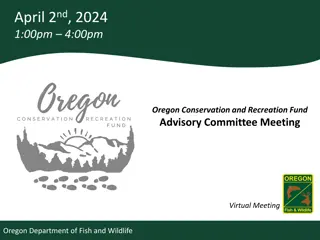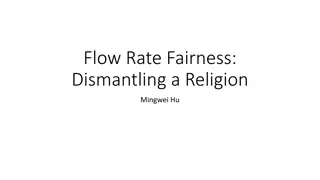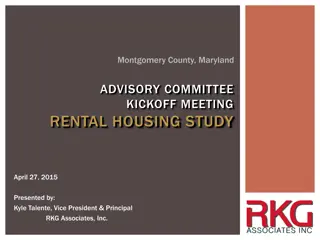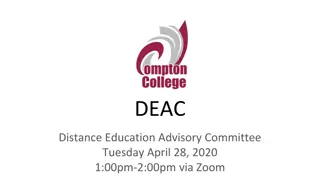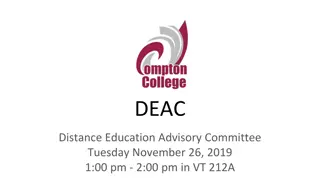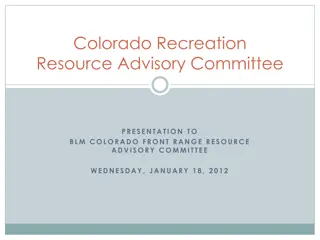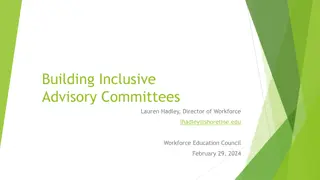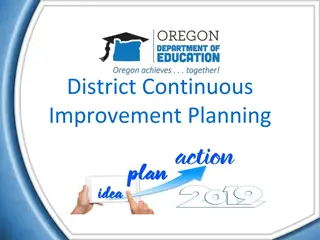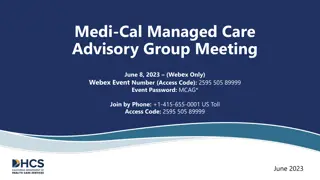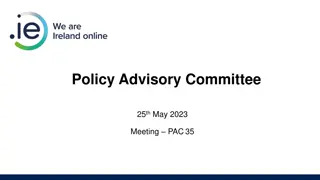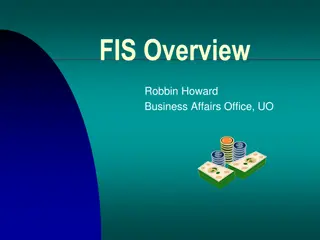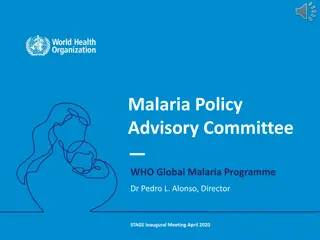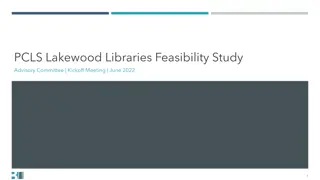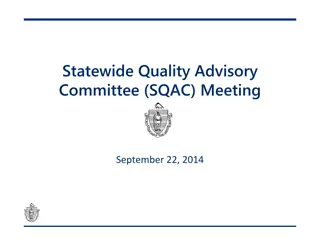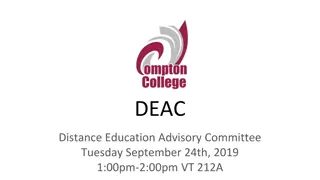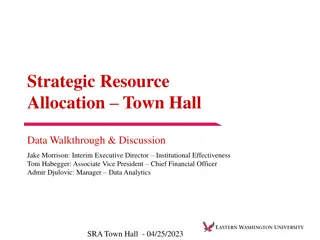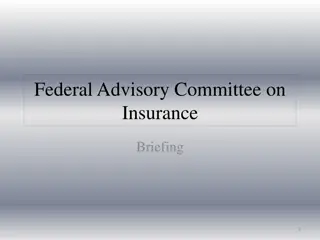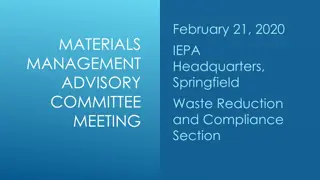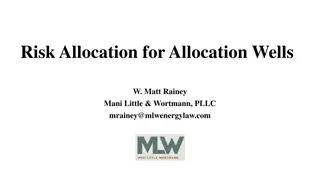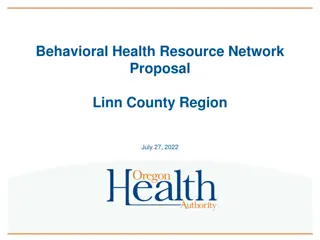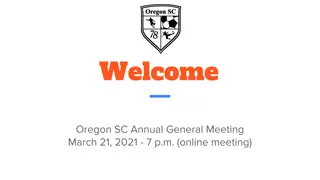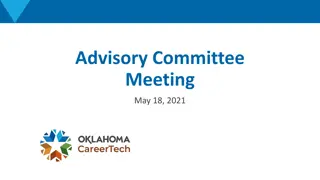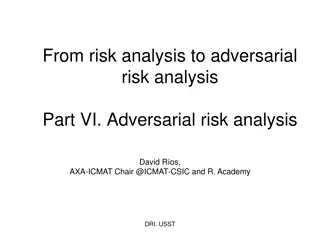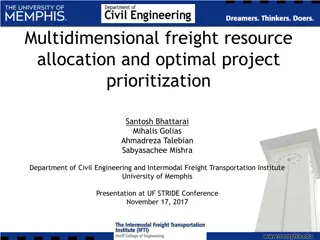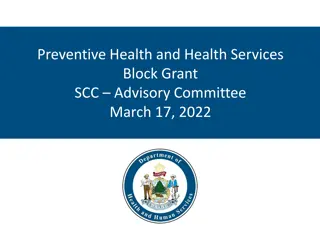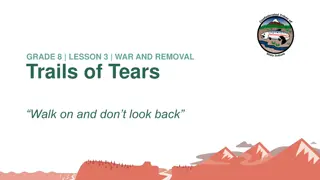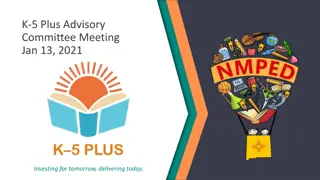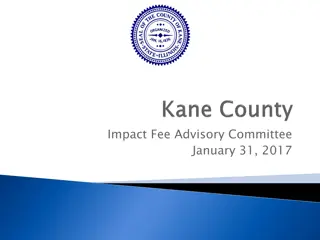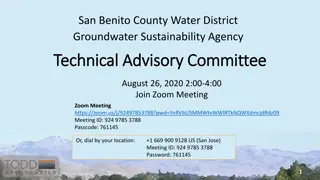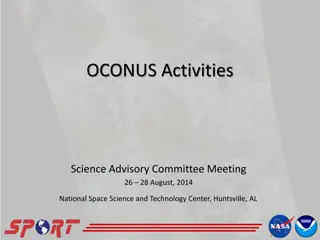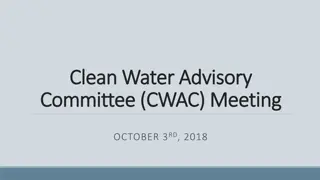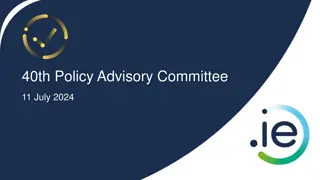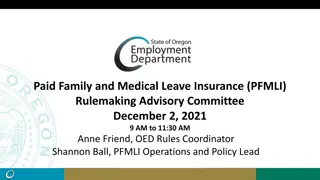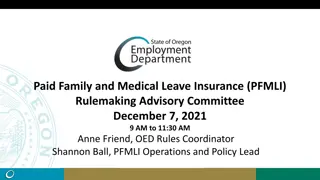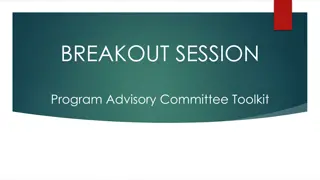Oregon Resource Allocation Advisory Committee Meeting - June 15, 2023
Resource allocation advisory committee meeting on June 15, 2023, includes instructions for Zoom participants, language interpretation options, meeting resources, purpose, agenda overview, and working agreements emphasizing diversity, inclusion, and respectful communication.
Download Presentation

Please find below an Image/Link to download the presentation.
The content on the website is provided AS IS for your information and personal use only. It may not be sold, licensed, or shared on other websites without obtaining consent from the author. Download presentation by click this link. If you encounter any issues during the download, it is possible that the publisher has removed the file from their server.
E N D
Presentation Transcript
Oregon Resource Allocation Advisory Committee Advisory Committee Meeting June 15, 2023
ORAAC Members Make sure your full name is shown in Zoom Click Participants Hover your mouse over your name Click more button (three dots) Click Rename Enter your name in the pop-up box Click Change You will be invited to join as a panelist Accept the invitation when it pops up 2
Spoken Language Interpretation Click the globe to enable interpretation options. Select the language. You can choose to hear the original audio at a lower volume or select mute original audio to stop hearing the original audio.
ASL Interpretation Select gallery view in upper right corner Click the interpreter s video Select the more button (three dots) Select Pin Video Be sure to pin video for both interpreters 4
Meeting Resources If you need support, we have: Simultaneous Spanish language interpretation Technology support Note taker If you have a need, contact Kristen Darmody at: 971-888-3358 Please note that this meeting will be open to the PUBLIC 1. The general public may be in attendance 2. The meeting summary will be posted to OHA s website 5
Purpose Close the deliberation process to begin drafting final recommendations 6
Agenda Welcome ORAAC Review Review: Written Public Comment & Community Conversations Public Comment Break Examples of Multi-criteria Approaches Discussion Closing Total 120 minutes (2 hours) 7
Working Agreements 1. Keep the patients and communities who have been marginalized by mainstream institutions, like the healthcare system, at the center of the discussion 2. Be mindful of paternalism in discussions about elders, people with disabilities, and BIPOC communities 3. Acknowledge the importance of all the services, supports, systems, and perspectives that are present in this committee 4. Be cognizant of how you speak and what you say so we can all understand one another 5. Recognize that participation and engagement looks different for everyone 6. Keep an open mind and come with a willingness to learn and to share 7. Move in the spirit of trust and love 8. Be clear in your communication 8
ORAAC Journey in Review May 2022 - May 2023 9
May through July 2022 History, definitions, and current status of crisis care guidance in Oregon ORAAC role and resources for members Develop meeting expectations Review and explore principles in promoting health equity during resource constrained events Patient led, patient-centered, and shared decision-making 10
August and September 2022 Presentations by Ruqaiijah Yearby, JD, MPH Structural discrimination and health inequity definitions, relationship to crisis standards of care Disadvantage indices Health justice Presentation by Derick Du Vivier, MD Examples of structural racism and racial biases in medicine and disparate health outcomes Review of race correction in clinical medicine and equity impacts 11
October through December 2022 Presentation by Alyshia Macaysa: Pacific Islanders in the Pandemic: role of community as a system and pandemic impact Triage definition and common approaches during a crisis Impact on health equity, with focus on survivability prediction tools Cultural values and community needs Ideal properties Triage Approaches Subcommittee, first meeting Review Oregon s Interim Crisis Care Tool 12
January through March 2023 Triage Approaches Subcommittee: explore triage options, including justification and drawbacks for each Expertise and consultation provided by Harald Schmidt, PhD, MA and Ruqaiijah Yearby, JD, MPH Full ORAAC meetings: Introduce and discuss triage teams and data collection; develop draft ORAAC recommendations Review Triage Approaches Subcommittee process and work to date 13
April and May 2023 Review all triage options discussed by the Triage Approaches Subcommittee Review and identify potential benefits and harms Collect the full committee s input on triage goal and commitments to hope and innovation Review draft committee recommendations regarding triage team and data collection 14
Reflection Question What is something new you have learned on the committee from someone who has had a different experience or perspective than you? 15
ORAACs Final Work June 2023 Today: close the deliberation process to begin drafting final recommendations Understand the concerns, questions, and suggestions from members of the public as the committee closes its deliberation process Complete the introduction of triage options by providing examples of multi- criteria approaches June 29: review final draft of ORAAC recommendations and input 16
Written Public Comment & Community Conversations Review Input To Date 17
Public Input Regarding Crisis Care Triage Options On May 23, 2023, the Oregon Health Authority (OHA) began requesting public input on crisis care triage options under consideration by the Oregon Resource Allocation Advisory Committee (ORAAC). The document for public comment outlines the options for public input and is available in 12 languages on OHA s website. The public comment period closes on June 26. All comments will be reviewed and considered by the OHA and a summary of public comments will be posted on the OHA s ORAAC webpage in July 2023. 18
Example Comments (1 of 4) Culturally Specific Communities Prevention is a priority to avoid pain, worry and anguish. Equitable chances caught my attention; resources should be distributed equally and impartially; discrimination should be avoided. There are barriers that create a huge gap between my community and resources available; the disconnect is due in part to language barriers; interpretation and translation of written materials are needed. Urgent resources and care for those with the most serious conditions should be given priority. Processes should be clear, smooth and easily understood and available in multiple languages. 19
Example Comments (2 of 4) Disability or Aging This work must consider the intrinsic biases and oppressive factors that exist in our current health care infrastructure; the disadvantage assessment is an essential component and should be included in the final triage approach. Under crisis and with limited preparedness, triage approaches typically devalue age and disability. Neither age nor ability should be used as criteria in the allocation of scarce resources; any standard that applies these criteria is opposed. 20
Example Comments (3 of 4) Hospitals/Inpatient Care Hospitals should be given flexibility to do what they can with the limited information and resources they have in the moment of an emergency. Health care providers deserve support and protection when they show up to do work on behalf of communities in an emergency. Combinations of triage criteria may be developed prospectively, though different crises may warrant different triage approaches to be used. Care must be taken to ensure that criteria are not discriminatory in violation of the law. A robust state infrastructure is needed to develop, manage and activate a triage model including staff training and the standardizing and streamlining of data collection. 21
Example Comments (4 of 4) Community-based Clinics/Public Health A patient s chance of survival if they don t receive the scarce resource should be assessed and factored into resource allocation decisions. Rural communities with limited access to a single critical access hospital with few hospital beds should be considered as part of crisis care guidance. For example, supplies may be an issue during emergency situations specific to freeway closures. Appreciate the framework suggested, the definition for triage, and the suggested options for focusing care. 22
Community Conversations The ORAAC project team hosted two sessions of community conversations. These sessions focused on engaging communities most impacted by health inequities and understanding their values, challenges they foresee, and ideas when it comes to crisis care. The concerns and experiences shared in the sessions apply to both routine health care, which can worsen health inequities prior to a disaster, and to crisis care. 23
Community Conversations 1. Community systems trying to fill the gaps in access to healthcare for communities that experience health inequities are always in a state of navigating crises and limited resources. 2. Non-English language accessibility is a significant challenge that healthcare must address to treat impacted communities. 3. Building trust between impacted communities and healthcare is important. Valuing and respecting the expertise of community leaders is important to better serve impacted communities. 4. There are a number of issues related to trust and listening to patients that healthcare must address. 5. End of life planning is not the norm in some impacted communities, and having conversations to end treatment can be difficult. 24
Break 26
Review: Triage in Crisis Care Guidelines During crisis care, triage refers to the prioritization process to determine which patient(s) will receive life-saving resources when there are not enough for everyone who needs them Triage is also called resource allocation ORAAC focus: provide recommendations to OHA regarding how to distribute limited, life-saving health care resources during an emergency or disaster when there are not enough for everyone
Multi-Criteria Triage Options Crisis care guidelines often utilize multiple criteria for resource allocation (called a multi-criteria approach ) rather than a single decision-making factor Choices to consider when choosing a multi-criteria approach include, but are not limited to: which criteria to include; what their underlying justification is; what weight (or importance) is given to each of the criterion; and the sequence in which they are applied.
Example steps for any crisis care triage approach: 30
Pre-triage Steps Confirm that patient requires the identified resource (e.g., meets admission criteria to the intensive care unit) Confirm patient preferences for care Determine whether adequate resources exist to serve all patients If not, move to crisis care triage 31
General Crisis Care Triage Steps If there are not enough resource(s) for everyone who needs and desires the scarce resource, initiate the following four steps of crisis care triage: 4. 3. 2. 1. Waiting list and reevaluation Apply tiebreaker if needed, and allocate resource Assign and confirm triage priority score Assess patients based on triage criteria 32
Triage: Step 1 Assess patients based on established triage criteria For example, assess likelihood of survival to hospital discharge ( survivability ) based on: Triage team (clinician) prognosis assessment; or SOFA, mSOFA; or Other survivability prognosis tool 33
Triage: Step 2 Assign triage priority score based on step 1 For example, based on prognosis for hospital survival Patients with highest likelihood to survive hospitalization receive priority first PAUSE and review Is the scoring clinically consistent? Are there potential biases? 34
Triage: Step 3 Equal priority resolution process (tiebreaker): In the case that two or more patients have the same triage priority score: If one of the patients is already using the resource, the resource stays with that patient (e.g., per Oregon s Interim Crisis Care Guidance) If not, apply another tiebreaker (e.g., equitable chances) Confirm resource allocation decision and communicate the triage priority score to the patient and clinical team Resource is then allocated to the appropriate patient 35
Triage: Step 4 Use a resource waiting list and interval re-evaluation For patients who receive lower priority scores and do not receive the needed resource during allocation Continue ongoing hospital care without the elevated resource Place patients who receive lower priority scores on a waiting list for the needed resource Reassess priority as resources become available Re-triage using steps 1-3 36
Oregon Interim Crisis Care Tool: Triage Algorithm Critical care triage algorithm (steps) based on survivability tool and additional equity corrections Full triage flow chart/algorithm available on page 9 as shown here Document available in 12 languages: https://www.oregon.gov/oha/Page s/ORAAC-Resources- Materials.aspx Forthcoming updates to this tool will be informed by ORAAC, public 37
Examples of Multi-criteria Approaches ForCommittee and Public Input A. Clinician Prognosis + Equitable Chances B. Clinical Prognosis, Life Cycle, and Equitable Chances C. Clinical Prognosis, Essential Worker, Multiplier Effect, and Equitable Chances 38
Example A: Clinician Prognosis + Equitable Chances Step 1: Clinician Prognosis: assess patient s chance to survive hospitalization. Group 1 gets highest priority for the resource, and Group 3 gets lowest priority for the resource: Priority Group 1 90% chance of hospital survival Priority Group 2 all others (e.g., 11-89% chance survival) Priority Group 3 10% chance of hospital survival Step 2: if there are not enough resources for patients in the same prognosis group, apply equitable chances criterion 39
Example A: continued Equitable chances criterion: Determine the disadvantage score based on the disadvantage index for their geographic residence Assign additional equitable chances weighting for patients based on their level of disadvantage, proportionate to impact (as measured by disadvantage index) Complete the automated, weighted randomization process (a drawing) using available software to determine who receives the resource
Example A: Who is Prioritized? Patients who have the greatest chance to survive hospitalization (a greater than or equal to 90% chance) based on clinician prognosis would be the first group prioritized; and Patients within this group who have experienced the greatest disadvantage would have the highest chance of being prioritized in front of other patients who have experienced the least disadvantage, proportionate to the impact the emergency had on the disadvantaged group 41
Example B: Clinician Prognosis, Life Cycle*, and Equitable Chances Step 1: Clinician Prognosis: assess patient s chance to survive hospitalization. Group 1 gets highest priority for the resource, and Group 3 gets lowest priority for the resource: Priority Group 1 Priority Group 2 90% chance of hospital survival chance survival) Priority Group 3 10% chance of hospital survival all others (e.g., 11-89% Step 2: if there are not enough resources for patients in the same prognosis group, patients who are in an earlier life stage (based on age) receive priority for the resource *OHA has significant concerns with using this option 42
Example B: continued Example life stages assignments: Childhood: 0-17 years old Early Adulthood: 18-39 years old Middle Age: 40-64 years old Older Adults: 65+ years old Step 3: Second tiebreaker: in the event there are patients in the same prognosis group and same life stage, apply equitable chances criterion to determine priority 43
Example B: Who is prioritized? Patients who have a greater than or equal to 90% chance to survive hospitalization based on clinician prognosis would be the first group in line for the needed resource; Patients in this group who are defined as being in an earlier life stage would have priority over patients in an older life stage; and Patients with the same life stage who have experienced the greatest disadvantage would have the highest chance of being prioritized in front of other patients in the same life stage who have experienced the least disadvantage, proportionate to the impact the emergency had on the disadvantaged group 44
Example C. Clinician Prognosis, Essential Worker, Multiplier Effect, and Equitable Chances Step 1: Triage Team determines prognosis for survival to hospital discharge for all patients: Priority Group 1 90% chance of hospital survival Priority Group 2 all others (e.g., 11-89% chance survival) Priority Group 3 10% chance of hospital survival Step 2: Prioritize based on: Essential worker verification and/or multiplier effect verification Step 3: Tie breaker: apply equitable chances weighted randomization 45
Example C: Who is prioritized? Patients who have a greater than or equal to 90% chance to survive hospitalization based on clinician prognosis would be the first group in line for the needed resource; Patients in this prognosis group who have an occupation that meets criteria for essential worker or multiplier effect would have next priority; and Patients with the same occupation-related priority who have experienced the greatest disadvantage would have the highest chance of being prioritized in front of other patients with the same prognosis and occupation-related priority who have experienced the least disadvantage, proportionate to the impact the emergency had on the disadvantaged group 46
Feasibility In a major health emergency, ease of implementation is an important consideration Resource allocation approaches, such as the examples previously described, can all be implemented readily via a methodological approach known as Categorized Priority System (also known as a reserve system) This custom-made, free-of-charge software has been developed to facilitate implementation of resource allocation processes 47
Questions? 48
Discussion Based on the public comment and community conversations shared, what changes or additions would you make to the input you provided OHA? Based on the examples of multi-criteria approaches shared, what changes or additions would you make to the input you provided OHA? 49


